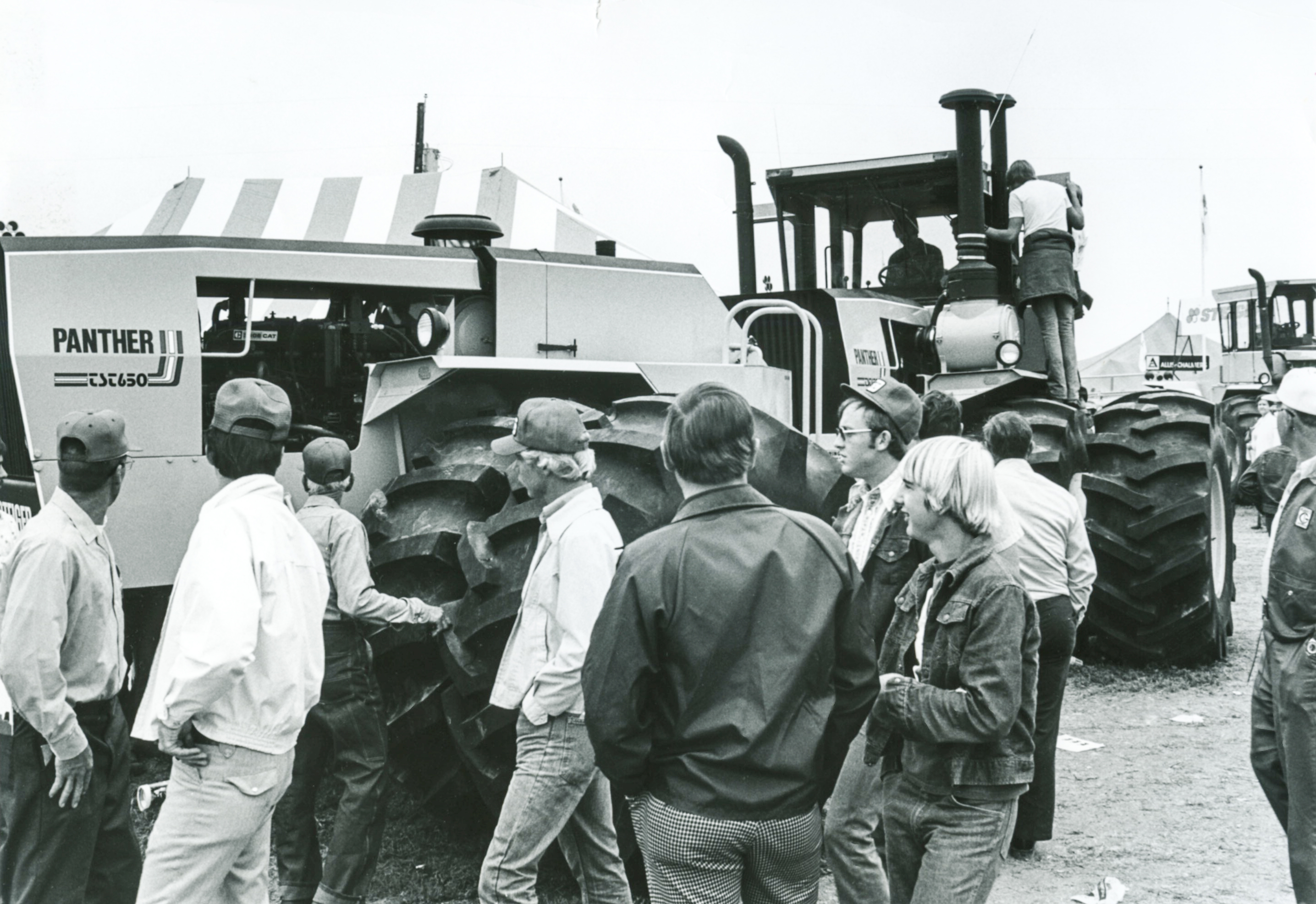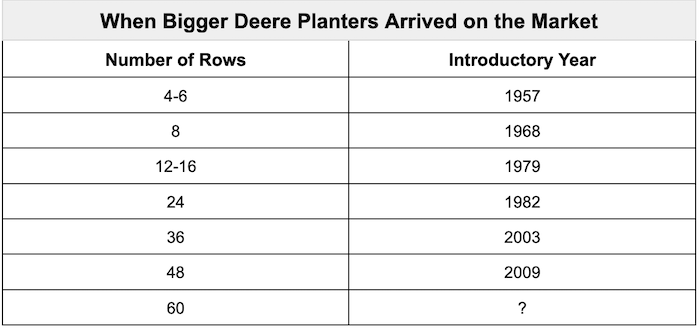.png)
With John Deere’s recent introduction of the 9RX series of high-horsepower (hp) tractors, farmers have the potential to get much more cropping work done in a day.
So how much theoretical capacity would this high-hp, high-priced tractor have when it comes to handling a 30-inch row no-till planter equipped with all the latest bells and whistles?
Just for Fun Math
My assumptions were based on the John Deere DB series planter specs for an 88-foot-wide front-fold 5-section and heavy-duty flex-frame setup for no-tilling in 22-inch rows. The no-till planter would arrive from the factory with variable-rate seed drives, hydraulic down force, row-by-row monitoring and either front-mounted no-till coulters or row cleaners.
Deere engineers place the planter’s weight at 47,700 pounds when the center fill tank is fully loaded with 125 bushels of seed corn. At 5-5½ miles per hour, the rig could supposedly plant 1,000 acres of corn on a dry and sunny 12-hour day.
“Planter would cover more than the width of a football field…”
I did the arithmetic based on the John Deere 9RX 830 tractor’s 913 maximum capacity hp. A 120-foot wide, 48-row no-till planter with 30-inch rows and all the latest technology led me to guess this rig would require 8 hp for each row unit.
So theoretically, this high-hp tractor should be able to pull a 114-row modern no-till planter. That includes having the hp needed to handle the hydraulics, down pressure, a 125-bushel capacity center fill tank and high-speed planting.
No-tilling in 30-inch rows, the planter would be 285 feet wide, which is 125 feet wider than a football field.
Among the highest horsepower tractors on the market today, the John Deere 9RX 830 with 913 hp could handle a huge acreage in a day’s time while pulling a 114-row modern-day no-till planter with all the latest technology set up for 30-inch rows. Photo by: Alex Gray, Successful Farming
650 Horses, 260-Row No-Till Planter
I remember spotting a 650-hp twin-engine articulated pair of connected Steiger tractors at the 1976 Farm Progress Show. At that time, I calculated for No-Till Farmer readers that a basic 30-inch row no-till planter with no fancy attachments needed 2½ hp for each row unit.
This worked out to pulling a 650-foot-wide no-till planter set up for 260 rows in a 30-inch pattern with this monster 2-engine tractor. A 260-row no-till planter would definitely be a special order — not a unit you would find sitting on a dealer’s lot.

Back in the 1970s, these twin-engine 650-horsepower articulated Steiger tractors would have had enough power to handle a 260-row basic no-till planter with 30-inch rows.
Old Rule Called for 2 ½ Horsepower per Row
Paul Jasa recalls when ag engineers indicated that 2 ½ horsepower (hp) was needed for each row on a no-till planter. The University of Nebraska ag engineer says a lot of that was to make sure the tractor was big enough to safely handle the weight. “I did a study about 40 years ago and it only required 1 ½ hp per row to pull a bare bones no-till planter without coulters, row cleaners or fertilizer openers,” he says. “That meant you probably only needed a 10-hp tractor with a 6-row planter.” As more features and attachments, such as hydraulic down pressure, have been added to no-till planters, Jasa says it takes a larger horsepower tractor to handle the weight safely both in the field and on the road. Today’s higher planting speeds also require more power.
Horses for 345-Foot Wide No-Till Planter
Then there’s the famous 1,100-hp Big Bud 747 tractor built in 1977 that is often seen at ag events pulling a 21-bottom moldboard plow.
Weighing 135,000 pounds when fully ballasted with 8-foot-tall tires and a full 1,000-gallon fuel load, this articulated power horse is used with an “acre-a-minute” field cultivator at the Williams Brothers farm near Big Sandy, Mont.
Robert and Randy Williams use this tractor and field cultivator to till to 7,000 acres of 12-inch row wheat and field pea ground that receives an average of 13 inches of moisture per year. Making 4 or 5 trips across these fields, the tractor works nearly 30,000 acres during each growing season. Big Bud also handles a very wide pull-type sprayer across these acres.
With its massive 1,100 hp, the original Big Bud 747 tractor should be able to handle a modern 138-row and 345-foot-wide no-till planter set up with 30-inch row spacings.
The Williams brothers no longer use this monster tractor to plow their ground, relying instead on no-till and minimum tillage. They only pull that 21-bottom plow at ag events for the enjoyment of attendees.
After a hiatus of not building giant tractors that stretches back over 40 years, Ron Harmon at Big Tractor Equipment in Havre, Mont., recently introduced a new lineup of Big Bud tractors featuring 650-750 hp engines.
Watch our 3-minute video about the no-tillers who own the world’s largest hp tractor below.
Seed 2,500 Acres a Day
The biggest no-till seeding rig I’ve heard about is a 212-foot-wide Australian-built air seeder designed and built by David Trevilyan. Back in 2006, he shared his ideas on using air seeders in a no-till system with attendees at our 14th annual National No-Tillage Conference. At that time, the owner of Multi Farming Systems in Moree, South Wales, was running a 120-foot-wide no-till air seeder with a seed cart.
I recall Trevilyan telling the no-tillers gathered in St. Louis that it takes about 4 hp to pull each shank and row unit setup with 12-inch rows under his dryland soil conditions. At one time, Trevilyan held the world record for seeding 2,337 acres in a 24-hour period with this 120-foot-wide rig.
Trevilyan also built a 212-foot-wide air seeder for Australian grower Gavin Zell. After testing a John Deere 9400T tandem tractor hookup, Zell used the MultiPlanter air seeder, along with two seed carts, to seed 47,000 acres of wheat, barley and chickpeas that the family raises near Collarenbri in South Wales.
Farming in an extremely dry and remote area, the Zell family had difficulty finding skilled drivers. A desire to run fewer tractors led them to buy this 212-foot-wide air seeder.
“Big enough to no-till 3,300 acres in a 24-hour day…”
A heavy-duty hitch mounted on the front tractor handles any uneven movement between the two tractors. Hydraulic lines running along one side of the rear tractor plug into the hydraulic lines on the front tractor. Each of the two hydraulic systems provides power for one of the two seed carts.
Seated in the front tractor cab, a driver controlled both tractors through electric cables, including a push/pull cable running from the front tractor to the transmission of the rear tractor for shifting both sets of gears. A GPS system and autosteering on the front tractor insures that the air seeder accurately follows the tractor while increasing maneuverability.
With each tractor burning 13 gallons of diesel per hour, Zell says running the rig at 5.6 miles per hour makes it capable of seeding 2½ acres per minute. During a typical 18-hour work day, the unit can seed 2,500 acres — or 3,300 acres in a 24-hour day. For highway travel, it takes an hour to switch the 212-foot seeder into an 18-foot-wide transport model.

Pulled by a pair of high-horsepower John Deere 9400T tractors, this 212-foot- wide Australian air seeder could seed 3,300 acres in a 24-hour day. Photo by: Gavin Zell
More Horsepower, Bigger No-Till Planters
So there you have it when it comes to demonstrating what might be done with these high-hp tractors in a no-till situation. It’s all theoretical and probably not realistic, but it shows how no-till can help harness the power of these monster tractors.







